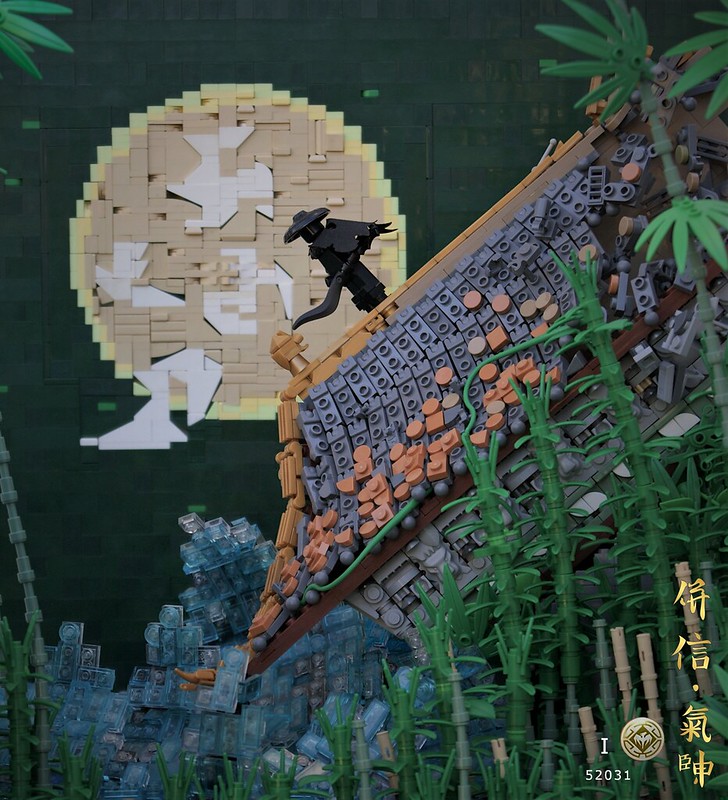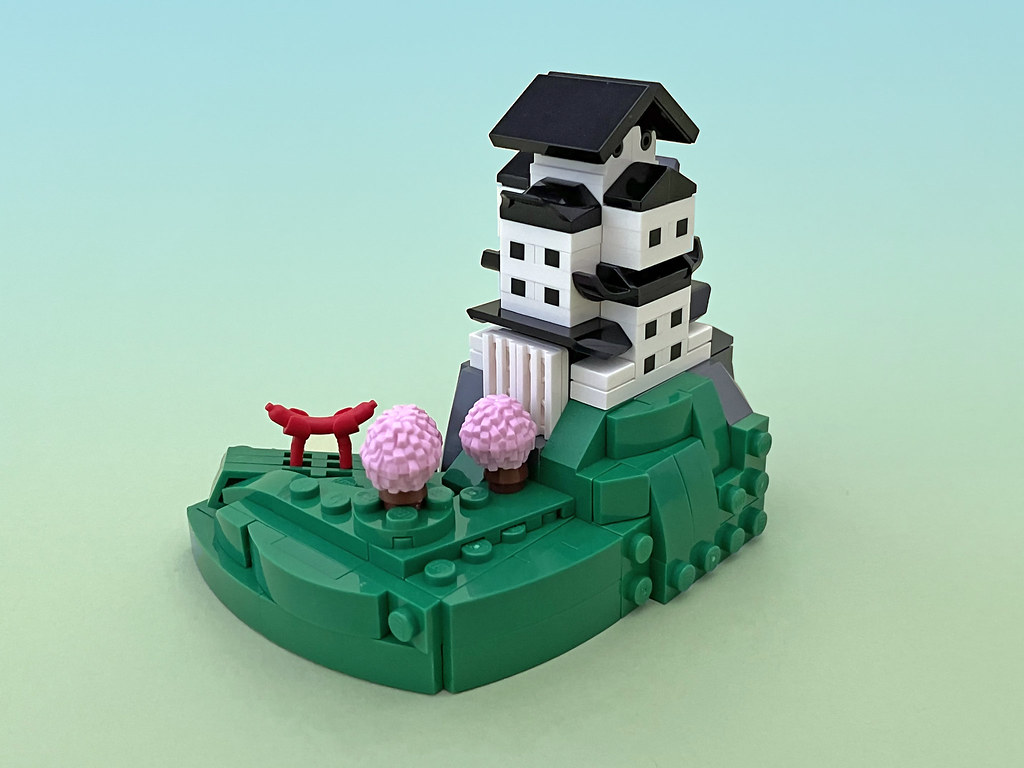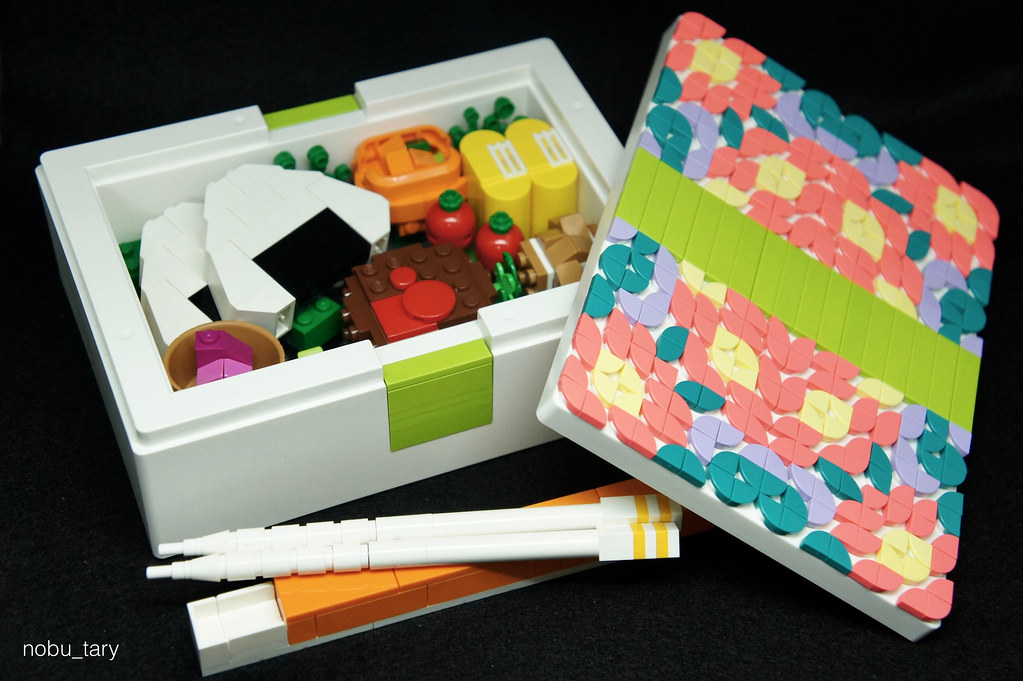Thanks to the Lego Ideas challenge: “Celebrate Japanese Culture” we’ve been seeing a lot of Japanese-inspired creations lately and we’re all for it. Oskar tells us this 2486-piece mosaic was built for that challenge and that eventide- 宵 (yoi) is a Kanji character symbolic of the hours of evening until midnight. It also signifies the eve of an event, particularly of festivals. In celebration of the many various flower festivals held in Japan, he chose to depict a flower motif blossoming from the warm orange glow of the setting sun – symbolizing the growing merriment on the eve of festivities. With this intention, he went with a blend of inspiration from traditional woodblock motifs and modern graphic design to offer a broader imagery of festive values both past and present in Japanese culture. I’m rather smitten by each petal; made from four triangular tiles.
Tag Archives: Japanese
Celebrate Japanese culture with the Plum Blossom
In a LEGO world of castles, spaceships, and battle mechs it’s sometimes nice to enjoy something a little different. Kristel Whitaker presents us with a stunning piece of art inspired by Japanese art. She tells us that the plum blossoms in Japanese culture represent hope, renewal and vitality, being the first to flower in spring (before the more famous cherry blossoms).The background is based on shoji, the paper sliding doors and windows common in Japanese homes. With the bold red sun against the white background, this piece almost looks like the Japanese flag, a notion that was surely not lost on a talented artist such as Kristel. This wouldn’t be the first time we were totally delighted by her LEGO creations. Please click the little blue link to peruse our Kristel Whitaker archives to discover more.
BrickCon 2023 Best in Show winner Kimberly Giffen talks about her LEGO rendition of the Silver Pavilion [Exclusive]
A little more than 11 months ago, I wrote up a beautiful LEGO tea house by my very talented LUG-mate Kimberly Giffen. That build, The Giffen Gardens, won Best in Show at BrickCon 2022. And here I am, after another BrickCon, pleased to say that Kimberly was able to repeat her achievement and win the Best in Show once again with a recreation of the Silver Pavilion (Ginkakuji) from Kyoto, Japan. I had a chance to talk with Kimberly after the convention about her work, and was able to learn a lot about the model and her process.

Read on about the Silver Pavilion below!
LEGO Icons 10315 Tranquil Garden [Review]
I’ve been excited and encouraged by LEGO’s latest push for sets that feature natural forms. Their botanical collection, specifically the 10281 Bonsai Tree, has embraced this concept deftly. And 10315 Tranquil Garden, releasing on August 1st, follows in that same vein, featuring the plants and structures of a Japanese garden in brick form. But will this set lead to serenity and peace-of-mind, or will it be a high-maintenance plot in need of constant pruning? Consisting of 1,363 pieces, the Tranquil Garden retails for US $109.99 | CAN $139.99 | UK £94.99.

The LEGO Group sent The Brothers Brick an early copy of this set for review. Providing TBB with products for review guarantees neither coverage nor positive reviews.
Japanese farmers in a bamboo forest
This creation by Ids de Jong exudes a sense of calm and quiet even though the creation represents a bunch of Japanese farmers that are about to put in a good day’s work. Ids used the candle piece in dark tan and green to represent bamboo. The parts haven’t been fully pushed together to mimic the structure of bamboo better. It is nice to see the Raya hat alongside the two types of conical hats that already were in production.
A LEGO builder in his element
If there’s anyone I trust to build a spirit consisting of the five elemental forces, it’s got to be Eero Okkonen. I mean, after all, the dude writes for a LEGO blog called New Elementary, so he’s got to be an expert! And, in typical “Eero” fashion, earth, wind, fire, water, and void aren’t the only elements excellently displayed here. That bending trunk of Bionicle bits looks so organic, especially in contrast to the stone corners of the nearby lantern. And I absolutely love the plating used for the warrior’s kusazuri, as well as the shaping of their hair. It seems very similar to the design for “Wind” within the kami, strands snaking down onto armored shoulders. The largely grayscale nature of the build helps to make all the colors pop out, even more, drawing the eye to the orange of the spirit, the pink flowers of the tree, and the gold worn by the warrior.
Need anything from the store?
At long last, builder Letranger Absurde has returned after an 18 month break from LEGO. And what better way to jump back onto the scene than with this beautiful Japanese store! Letranger adeptly uses textures here to emulate paneling on the wooden walls and tiled roofs. This helps to break up the mostly two-toned building, providing depth and character. Speaking of character, I love the pair of fences flanking the store. Without looking completely ramshackle, these dividers still add a hand-crafted feel to the setting. Lay on top of that other excellent details like the power pole in the background, the exquisite sign above the storefront, and the darling cart of produce in back, and I suddenly feel like going on a shopping spree.
And if Letranger Absurde is a new name for you, check out all their prior builds featured on TBB.
A mysterious warrior takes a moment to reflect
This mystical scene comes from the creative mind of W. Navarre. In the build, we see the silhouette of a figure perched on a rooftop, with the roof tiles cleverly portrayed through the use of ball joint plates. The warrior is overshadowed by a bright moon, which has a great variation of textured pieces representing the rocky surface. Waves crash against the house surrounded by a bamboo forest, featuring the use of tan Technic pins as bamboo stalks. The odd angle of the house mixed with the mystical aesthetic makes this one unique display.
Microscale temple is a miniature masterpiece
When building microscale, you need to look at parts a little differently, as evidenced by the very creative collection of curved and angled parts Nannan Zhang used on this Japanese castle. Front fenders, rear spoilers, and other small black parts usually found on cars create a tiered roof that reminds me of Nagoya Castle. A trio of cheerleader pom-poms make perfect cherry blossom trees, while a hot dog is used for a small arch. Almost as interesting as the castle is the green and gray landscape it sits on.
Fiendishly fearsome fantasy figure
Beyond Japan, Yōkai are often assumed to be demons, but the word actually translates as “strange apparition” and these mystical spirits are not always malevolent. Having said that, Rockmonster2000‘s LEGO yōkai figure looks pretty mean! The stance, the stare, that weapon — they all strongly suggest this beastie is about to unleash some diabolical mayhem. There’s quite the mix of parts involved in this character — I spy regular System bricks, Technic panels, and Bionicle and Knights Kingdom pieces. That braided piece of clothing around the midriff looks like a shoelace to me — I do hope it’s an official LEGO one from 10282! My favourite detail though, that has to be use of the bucket-handles as clasps on the sandal buckles. Lovely stuff.
Journey to Mount Kōya along the path of the gods
I’m watching the delayed Tokyo 2020 Olympics right now feeling nostalgic both for my hometown and for my trip back to Japan two summers ago before the pandemic, when I spent several days in Kyoto as well as Tokyo, Matsumoto, and Kobe. Just south of Kyoto stands Mount Kōya, where Kōbō Daishi (Kūkai) founded the Shingon sect of Japanese Buddhism in the 9th century. My father became good friends with the head monk of Kōya-san during our time in Japan, and the temples and pathways there hold a special place in my family’s hearts. Inspired by the Japanese manga Mushishi by Yuki Urushibara, LEGO builder Ted Andes has captured a Buddhist pilgrim pausing at a Shinto shrine in the Okunoin graveyard where Kōbō Daishi is buried.
What’s truly wonderful about this scene is that it captures the unique Buddhist-Shinto syncretism that permeates Japanese spirituality, wherein Shinto (literally the “Way of the Gods”) beliefs are practices alongside Buddhism brought from China. In Ted’s LEGO scene, a shrine to a local Shinto deity and the god’s sacred stone — complete with a straw rope with lightning-bolt paper — stand amidst Buddhist graves on a sacred Buddhist mountainside. Well-researched, gorgeously detailed scenes like this are a welcome contrast from the generically “Asian” scenes far too many western builders toss together for build challenges and contests.
As part of the same Summer Joust contest, Ted also shared this atmospheric scene inspired by the same Manga. The same pilgrim from the scene above walks through a bamboo grove at night as ghost tendrils and a spectral hand threaten our protagonist. Rather than relying on LEGO’s bright green bamboo pieces, Ted has recreated the tall stalks using dark tan candles, with just a few leaves entering the frame near the top. This sort of scene is exactly why little kids like me growing up in Japan were afraid of bamboo groves at night!
Forgot your lunch? Here’s a BYGGLEK Bento Box.
In my youth I used to watch a lot of anime, and of course with most of it being created in Japan during that time, snippets of daily Japanese life found their way into the animations; school uniforms, cherry blossom trees, and of course Bento boxes – neatly home-packed meals. The fairly new BYGGLEK boxes produced as a collaboration between LEGO and Ikea are perfect for creating LEGO Bento, which builder nobu_tary has expertly done here.
Rice balls, veggies, and more! These foodstuffs are all expertly brick-built, some – like the rice balls are constructed by way of the SNOT (studs not on top) technique, utilizing some basic pieces such as slopes and bricks and others such as the two tomatoes are built regularly and are composed of only a couple pieces. These colorful food builds certainly capture the colorful palette of Japanese cuisine. The cover of the box is also colorfully decorated with a nice mosaic pattern built out of variously shaped tiles which can be found in the LEGO Dots line. Nobu_tary did not forget the utensils either – the chopsticks here being shaped by various cone and cylinder pieces topped with some 1×1 bricks and plates. Certainly this build is a palatable one indeed.










